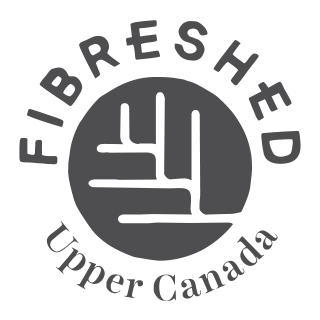Melinda is the co-owner of Lickety Spit Fibre Farm, a family farm raising alpaca and sheep. She runs the business with her neighbor and business partner, Michelle. The farm is located in Binbrook, Ontario.
Nadine is a knitwear designer at Nadine Mcleod Designs and teacher based in Burlington, Ontario. You can find her designs on Ravelry were she caters to more experienced knitters who might enjoy a good lace, texture and/or beaded embellishments. She is currently working on a line of finished products that include baby blankets, snuggles, home fashions that are created by hand knitting as well as machine knits.
Here are some snippets of my conversation with Melinda and Nadine.

What was it like working together?
Melinda (M): We were a match made in heaven. We met for coffee that turned into a 2-hour lunch.
Nadine (N): Mulberry – it’s a great place to meet, great meal, it was like we had always known each other. We really could have sat and chatted all day.
M: We talked about the fibres as well as the colour and what it means to “embrace the natural colours”? It’s brown and ivory but it’s not 1970s brown – it’s very a very rich and gorgeous brown. Supply was the biggest challenge.
N: I wanted to design a baby blanket that would showcase the intrinsic characteristics of the alpaca and alpaca/sheep blended wool.
Would anything have made the process easier?
M: Nothing would have made it easier – working with Nadine was awesome. We had a great connection and our lives seem to be crossing paths all over the place since we met.
N: I agree. Working with Mel was a collaboration made in heaven. We found that we have so many things and people in common.

My Interview with Nadine
Nadine’s grandmother taught her to knit when she was five years old. Knitting was something that they could do together and keep a hyper-active child busy knitting clothes for her dolls. She feels it was one of the best gifts she ever received. As an adult, her designs are inspired by nature and she is passionate about using natural material and protecting our biosphere and she loves to share her skills with others. All her products strive to have the lowest possible environmental impact, from the source of the fibres, to the source of the fibre, and the natural colours to producing knits either by hand or machine (which does not require electricity at this scale). She adores the alpacas, “I love everything about them – both the animal and its regenerative fibre”.
Nadine believes strongly in the power of community and often makes time for networking. She is a regular member of the Toronto Knitters Guild, and a board member of the Upper Canada Fibreshed. She loves collaborating and is such a dream to work with.
I asked Nadine what she likes best about being a professional designer. “I love the creative aspect. I love having things I’ve made, especially knitting, and I like sharing it with people.” As for important skills you need to success in this business? “A knitwear designer must have good knitting skills, good math and marketing skills. Attention to detail is crucial…and a great tech editor is a must.
Are there any challenges in designing for baby?
N: Knitting items for baby means that the knits need to be washed. There is a pre-conceived notion that you can’t wash wool – which is not true. Plus, there are so many benefits of a natural fibre against a baby’s skin. Caring for the blanket will allow it to be passed down as an heirloom to the next generation.
Wool and alpaca are naturally flame retardant fibres and do not have the toxins of made-made fibres.
What is your design process?
N: I really let the type, weight and colour of the fibre inspire the design.
For this design, Mel and I talked about wanting to show the fibre in the best way. I wanted to use different stitch designs to showcase the stitch definition of the fibre and the natural colours but not make it too heavy.
I started by knitting a number of swatches to see what stitch patterns and colourwork best complemented each other. Once the design had been chosen, the pattern was written, and the blanket knit with a few modifications along the way. The pattern was then graded to different sizes. Once completed, the pattern was tech edited where a technical editor meticulously went through the pattern to ensure accuracy including the math and spelling throughout the pattern.
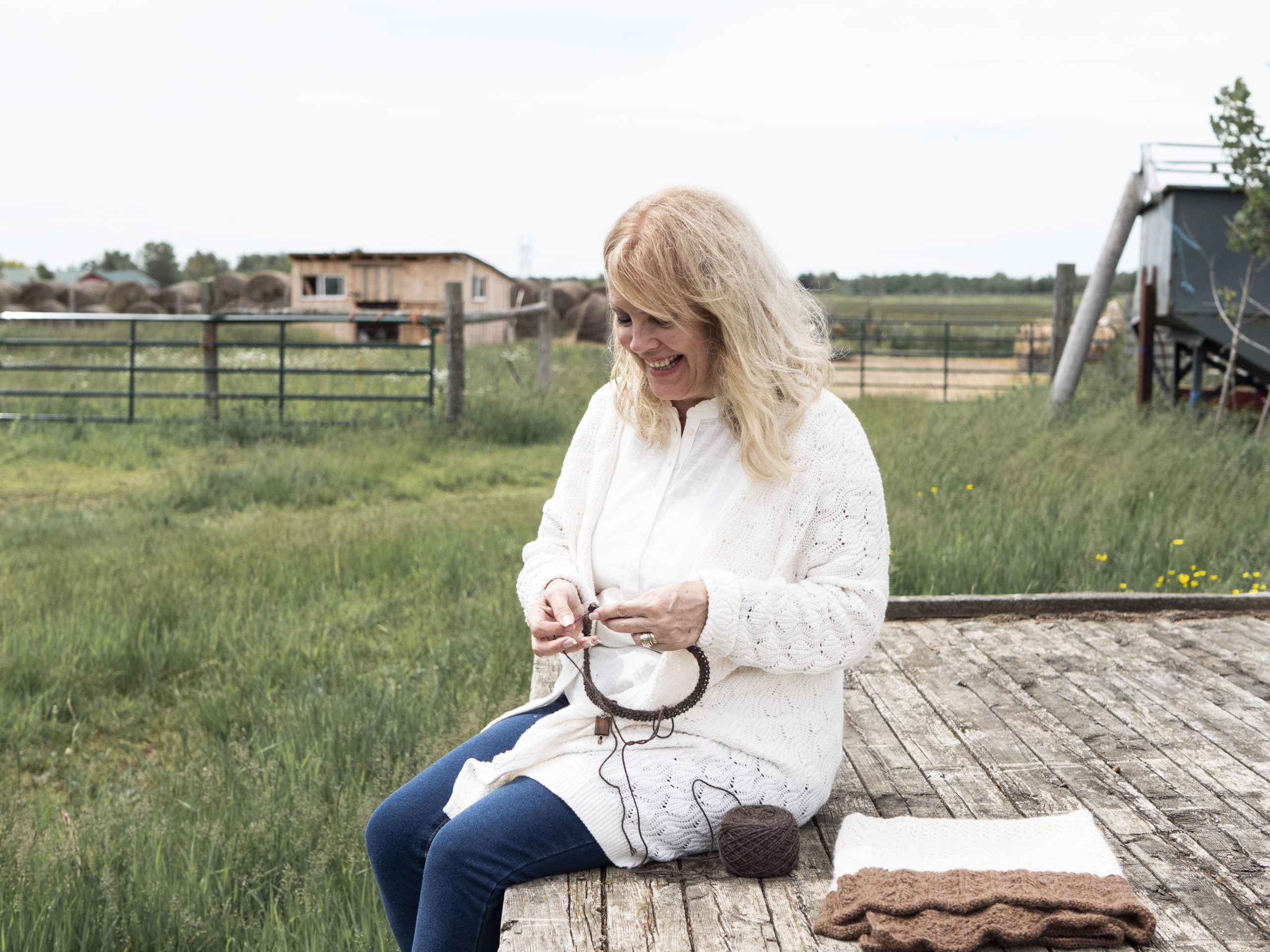
A Surprise During the Interview
During our farm visits, Emily will often take a break from chatting to go take pictures of the animals. At one point during the morning, Emily went running full tilt across the property. One of the alpacas was in labour and the baby was ready to be born! Completely unexpected by any of us, farmers included, as she wasn’t due for a few weeks. We all rushed over to Melinda and Michelle to help with the birth, the rest of us to observe. The other alpacas surrounded the mother and were humming and watching. The baby was born! It happened so fast. The little one needed some extra care, so the other alpacas were herded to another pasture. As the baby recovered, our heart rates returned to normal and we were able to carry on after taking quite a few pictures of the little cutie. What a remarkable and welcome interruption to our interview.
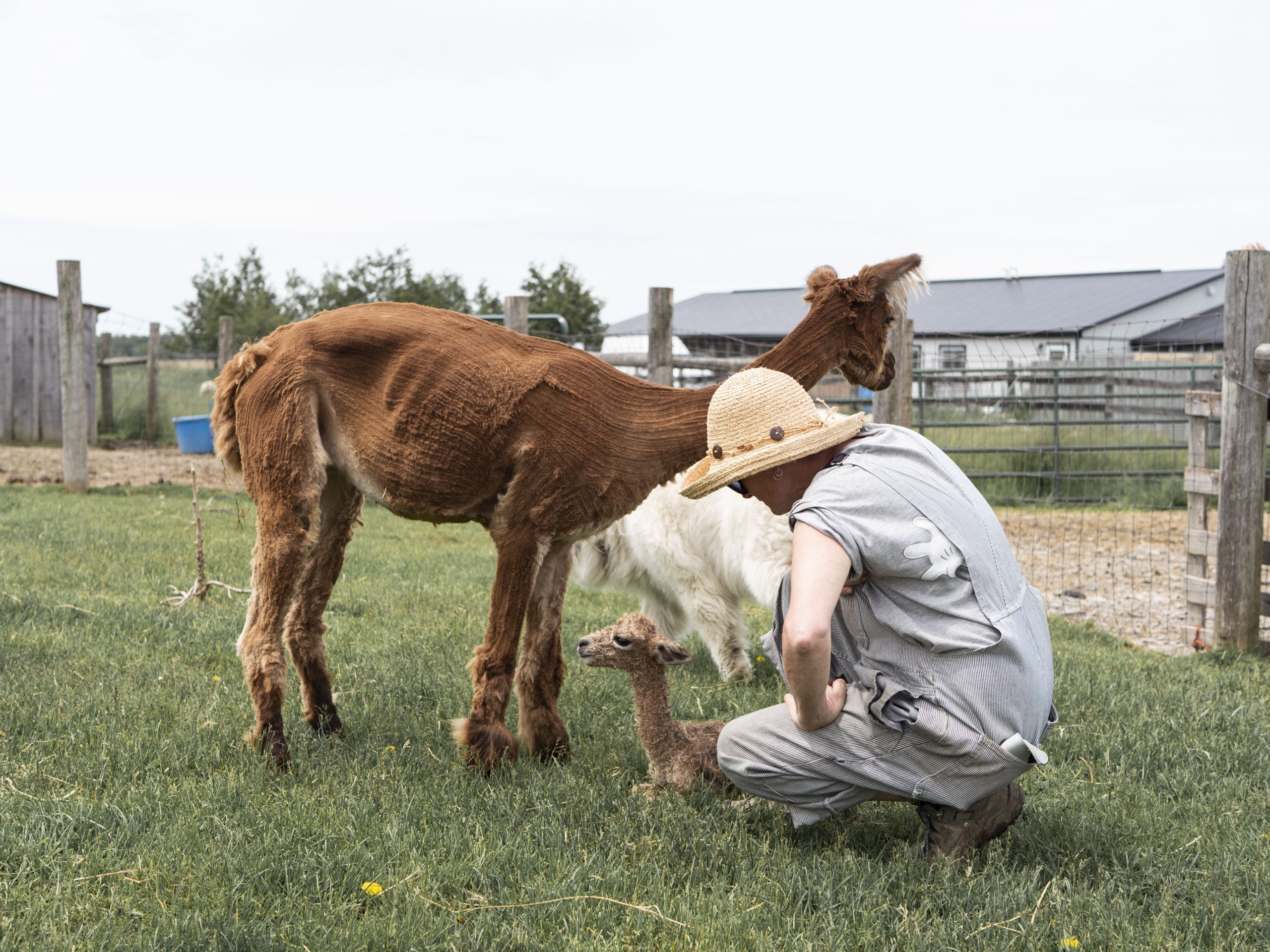
My Interview with Melinda
Melinda actively searches out and creates new venues for people to connect with the local fibre products. She is the organizer of LandMade, the Alpaca Ontario Spring Show, and a new Fibre market in Hamilton.
Melinda, who lives on your farm?
M: We have 37 breeding sheep and 41 lambs. The breeds are pure Icelandic and Romney and we have one Border Leister. We inherit animals through Animal Control. When no one claims them, we keep them. We have four conventional sheep and a few mixes with BFL and Romney, a few Icelandic BFL cross. We had a BFL ram mature faster than we expected, and he was breeding them.
We have 24 alpaca with five on the way – all Huacaya alpacas.
Any management practices you’d like to share?
M: We struggle with the milling. I don’t want to send it to the US (the shipping would cost too much for the amount of wool). The average Romney ewe have 15 lbs. of raw wool, the rams were 17 lbs. last year. One sheep fleece is equal to three alpaca fleeces. The mini mills are popping up but so are fibre farms. Milling – if I don’t look at climate change – is our biggest challenge.
(For a minute we chatted about the challenges of climate change in the present, lamenting a similar story to Linc Farm’s Juliette about being able to grow enough fodder for the livestock now with the unpredictable and dramatically different weather).
Every immediate consequence has expanding ripples six months down the road. We have maybe a week left of the first-cut hay. We have seconds, but it’s not ideal for the pregnant ewes. We send them out to pasture, but then that pasture doesn’t get turned into first-cut hay, which means that we’re generating less hay than last year. We can’t get into the field to cut the hay, it’s still too wet. There aren’t enough dry days. We’re looking into bailage. We were going to have our friend Len down the road do it, but he’s in the same boat. He can’t get the corn into the field. Will there be enough time to dry the corn in the fall so his cows have enough to eat? People are struggling. On a day to day, our challenge is we have off farm jobs. There is no down time and we feel like we’re always behind. The upside is being we can afford to bring in hay.
At the fibre community level, what are the challenges?
M: The challenge, and the common denominator is, we all have wool.
The goal is for consumers to choose Canadian made products. However, we can’t manufacture Canadian made products for all the reasons that we know – so then the question is, is it possible to not always be a cottage industry? We are currently a cottage industry. Time, plus processing, plus supply and all of (us) these people are scraping by and you still get expensive product.
Historically, the percentage of what people would spend on food was more, but so was clothing. It was a totally different mindset of the consumer and different mindset of the labour force. Working class meant that your Dad was passing down a trade and you didn’t expect to have a different outcome in your life. Now everyone wants everything – we have a completely unrealistic vision of what a quality of life means and it’s all driven by consumerism. People don’t want to have hand-me-downs or second-hand clothing. When I grew up, my mom had a dress maker. Now there is nothing like that.
What do you love about farming?
M: Love about farming….oh, pretty much everything. How could you not? There is a lot of stress, it is physically demanding, it’s hard when you have a loss or an injury. It resonates with what is fundamental about us as a species. We are working to eat. Even though I’m not eating lamb, I’m vegetarian, but it’s that same activity that our species has been doing since going beyond eating bark.
If you’re going to farm, you need to be able to develop the ability to work in a crisis. Hay, injury, getting the hay in before it rains you need to learn not to lose your head.
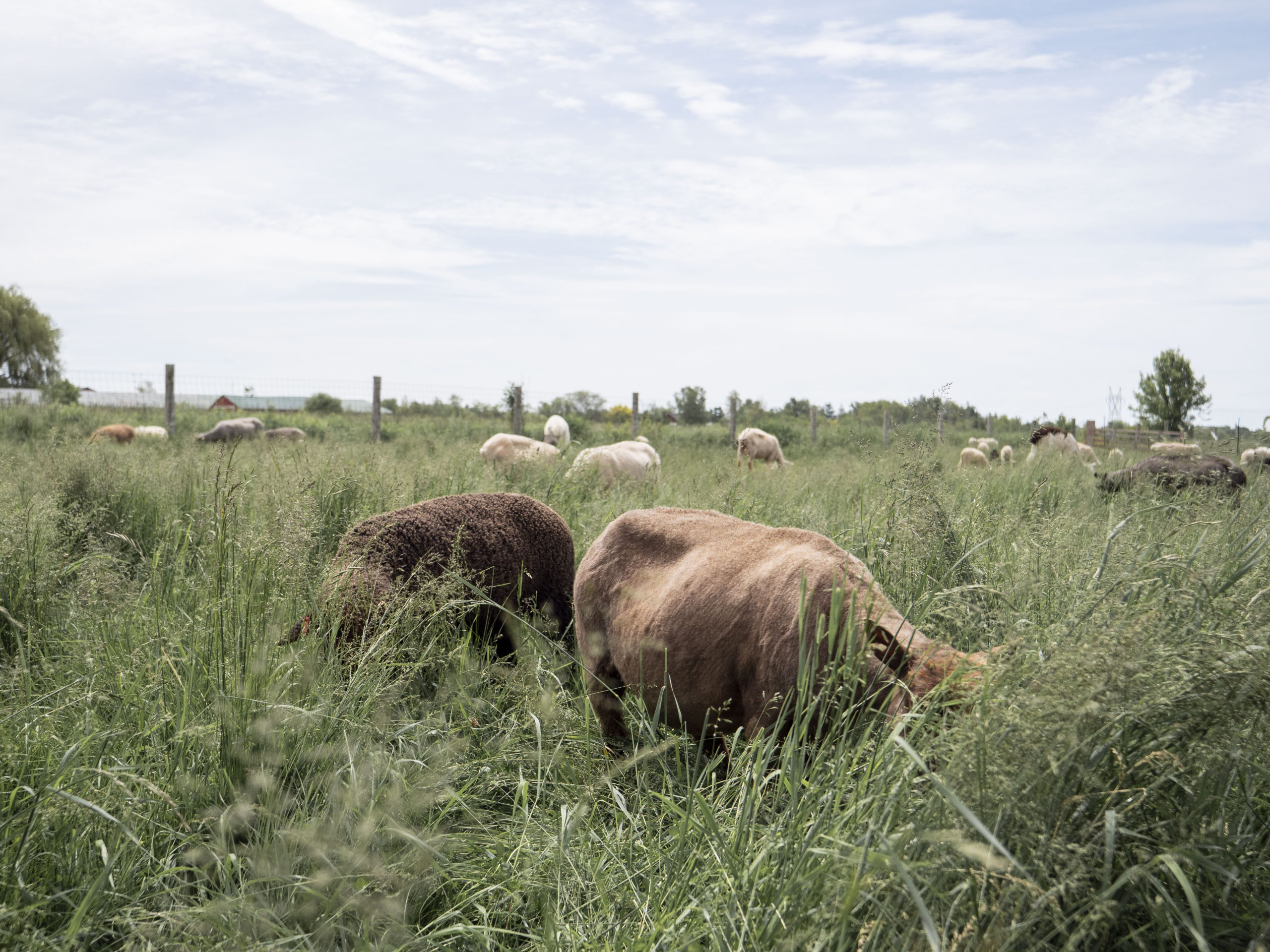
What is your favorite tool?
M: I’m grateful for the bobcat.
What does being on the land mean to you?
M: It’s a fundamental part of being a human. I feel very lucky that I have the opportunity to do it; it gives me purpose. I think it would resonate with more people than they would probably think. If you get past the stereotypes, and even if you’re just going to have a small garden, or chickens, there is something that is fundamental about feeding yourself. We have removed ourselves so far from that, that if you can learn to feed yourself and the thing that feeds you, that is on a cellular level an instinct.
Nadine and Melinda connected for this Farm Raised Fashion project over lunch – and found out they are kindred spirits. Together they created this gorgeous alpaca, and alpaca/Romney blend baby blanket. Perfect for a stroller to keep extra cozy of those crisp fall days, the colours are neutral, natural (undyed), the alpaca is hypoallergenic, super soft next to baby’s skin, and best of all, washable (just don’t put it in hot water or agitate it – and lay it flat to dry).
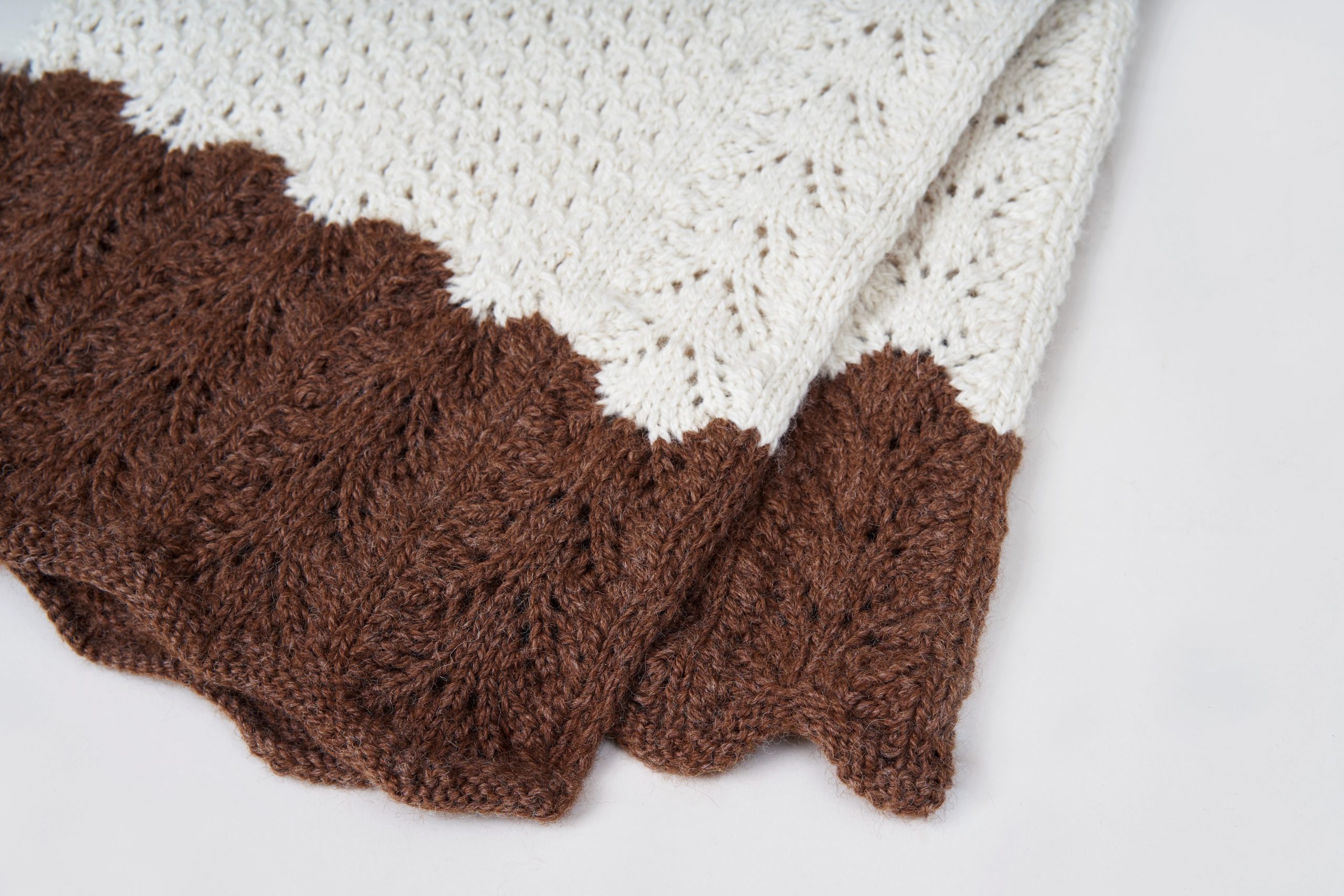
Shop the Pattern
Photographed by Emily Neil; Written and produced by Becky Porlier.
